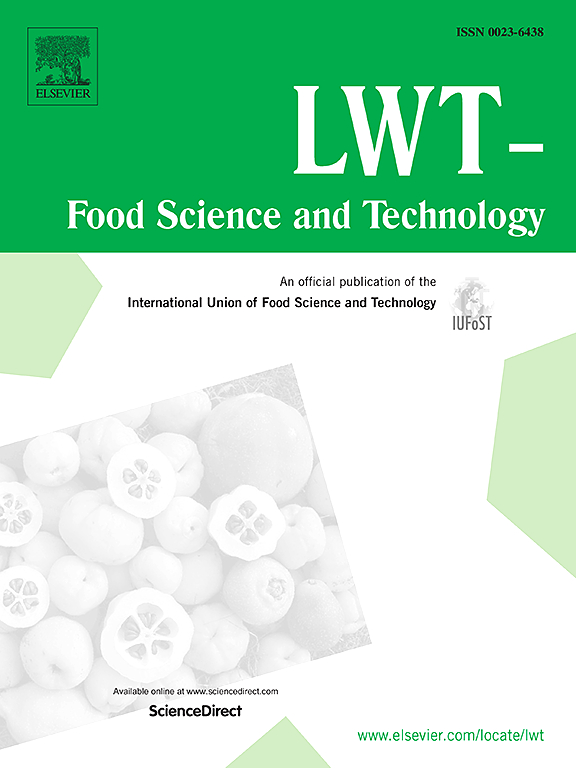以蛋白质为原料的鱼肚的膨化可行性和挥发性化合物特征
IF 6
1区 农林科学
Q1 FOOD SCIENCE & TECHNOLOGY
引用次数: 0
摘要
鱼肚干因其柔软的口感和丰富的营养成分而受到消费者的青睐。然而,鱼肚的市场潜力受到复杂的前处理工艺和即食鱼肚产品缺乏的不利影响。本研究调查了将膨化技术应用于以鱼肚为例的蛋白质原料的可行性,以指导即食鱼肚产品的开发。在最佳膨化条件下(230 ℃ 3-4 分钟;250 ℃ 2-3 分钟)获得的膨化鱼肚具有蓬松的微观结构和均匀的孔隙排列。经鉴定,膨化鱼肚中的主要挥发性化合物包括芳香成分、氨、氢化物和短链烷烃。各实验组的芳香成分释放量随着温度和膨化时间(230 ℃ 2-4 分钟和 250 ℃ 2-4 分钟)的增加而增加。特定膨化条件(230 ℃ 3 分钟、230 ℃ 4 分钟、250 ℃ 2 分钟和 250 ℃ 3 分钟)的应用促进了挥发性化合物的积累,如辛醛、壬醛、戊醛、庚醛、乙醛、丁醛、丙醛和丁二烯、庚醛、3-辛酮、2-甲基-2-戊烯醛、2-戊基呋喃、2,6-二甲基吡嗪、反式-2-庚烯醛、(E, E)-2,4-辛二烯醛、反式-2-戊烯醛、2-己烯醛、辛醛、3-甲基-2-丁烯醛、2-甲基戊烯醛和苯甲醛。本文章由计算机程序翻译,如有差异,请以英文原文为准。
Feasibility of puffing and volatile compounds characteristics of fish maw, a protein-based raw material
Dried fish maw is preferred by consumers due to its soft texture and rich nutritional profile. However, the market potential of fish maw is adversely affected by the complex pre-treatment processes and absence of ready-to-eat fish maw products. This study investigated the feasibility of applying puffing technology to fish maw as an example of protein-based raw materials, to guide the development of ready-to-eat fish maw products. Puffed fish maw obtained under optimal puffing conditions (230 °C for 3–4 min; 250 °C for 2–3 min) exhibited a fluffy microstructure and uniform pore arrangement. The primary volatile compounds identified in the puffed fish maw included aromatic components, ammonia, hydrides and short-chain alkanes. The release of aromatic components increased with increasing temperature and puffing time across the experimental groups (230 °C for 2–4 min and 250 °C for 2–4 min). The application of specific puffing conditions (230 °C for 3 min, 230 °C for 4 min, 250 °C for 2 min and 250 °C for 3 min) facilitated the accumulation of volatile compounds such as octylaldehyde, nonylaldehyde, pentylaldehyde, heptylaldehyde, 3-octylone, 2-methyl-2-pentenal, 2-amylfuran, 2,6-dimethylpyrazine, trans-2-heptenal, (E, E)-2,4-octadienal, trans-2-pentenal, 2-hexenal, caprinal, 3-methyl-2-butenal, 2-methylpentenal and benzaldehyde.
求助全文
通过发布文献求助,成功后即可免费获取论文全文。
去求助
来源期刊

LWT - Food Science and Technology
工程技术-食品科技
CiteScore
11.80
自引率
6.70%
发文量
1724
审稿时长
65 days
期刊介绍:
LWT - Food Science and Technology is an international journal that publishes innovative papers in the fields of food chemistry, biochemistry, microbiology, technology and nutrition. The work described should be innovative either in the approach or in the methods used. The significance of the results either for the science community or for the food industry must also be specified. Contributions written in English are welcomed in the form of review articles, short reviews, research papers, and research notes. Papers featuring animal trials and cell cultures are outside the scope of the journal and will not be considered for publication.
 求助内容:
求助内容: 应助结果提醒方式:
应助结果提醒方式:


